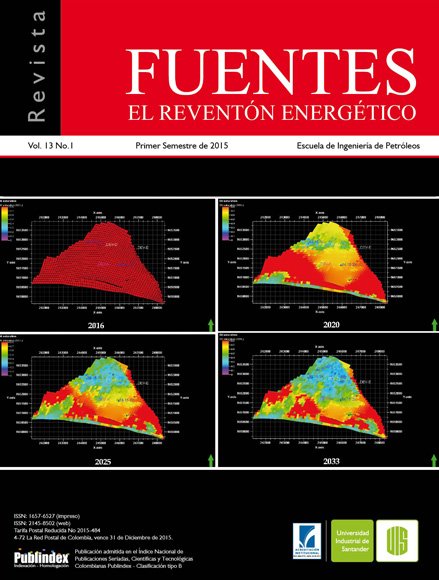Thermodynamic characterization of reservoir at high pressure and temperature: study case block 64
Published 2015-08-11
Keywords
- Thermodynamic Characterization,
- High Pressure Reservoir,
- Phase Diagram
How to Cite
Abstract
The discovery Situche Central Field in Block 64, was a big step in the Petroleum Industry of Peru history, because it is the most important discovered place of light oil in the last 25 years in the Maranon Basin, also the technological challenges like: the drilling deep wells, the handling of reservoirs growers formation pressure and high temperature background, make it a defiance.
The characterization of the thermodynamic behavior of hydrocarbons from a reservoir located deep, under high pressure and temperature background, is an extremely important task which requires: verify the stability of the operating conditions during sampling (separator pressure , temperature separator, GOR), verify the representativeness of the samples collected in background and/or in surface, and validate the consistency of the laboratory tests , flash release , differential and testing of separators. After verifying the consistency, the phase diagram is constructed to identify whether the site is high or low shrinkage, and if necessary use a state equation or a set of tables of properties for dynamic modeling.
The construction of the phase diagram required to apply the best practices of the industry in terms of the grouping of the heavier components (C7 + ) , considering its high incidence in the thermodynamic behavior in the hydrocarbon mixture; trial and error procedures and numerical regression were defined to achieve the best fit of the prediction equation of state ( EOS ) and in the observations of experiments flash and differential release ; finally, once calibrated the EOS and exported the PVT table, predictions were made in the dynamic numerical simulation model .
Downloads
References
2. Danesh, a. (1998). Pvt and Phase Behavior of Petroleum Reservoir Fluids. Elsevier.
3. GeYe-PetROPeRu. (2013). initial Development Plan – situche Central field – Block 64.
4. Pedersen, K. et all. (1992). Pvt Calculations on Petroleum Reservoir Fluids using Measured and Estimated Compositional Data for the Plus Fraction
5. RePsOL Peru, e&P. (2009). validación, evaluación y elaboración del informe Pvt.
6. Rojas, G. (2000). ingeniería de Yacimientos de Gas y Gas Condensado
7. sampling Petroleum Reservoir fluids. (2003). aPi Recommended Practice 44 Second Edition.
8. stamataki, s. Magoulas, K. tassios, D. national university of athenas. (1997). Prediction of Phase Behaviour and Physico-chemical Properties of Ht-HP Reservoir Fluids. SPE 37294.
9. Whitson, C. & Brulé M. (2000). Phase Behavior. sPe Monograph.
